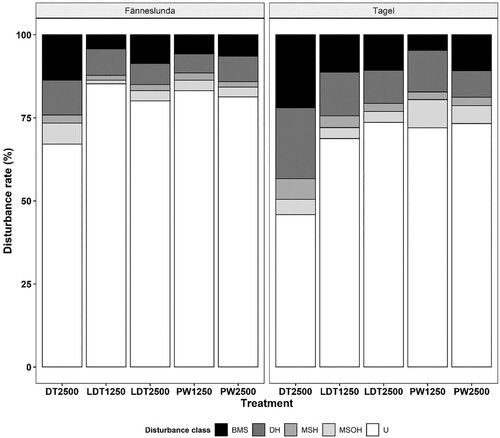Figures & data
Table 1. Information about the two study sites.
Figure 1. The design of the different site preparation treatments which were tested in the study. (1) DT2500, Conventional disc trenching, (2) LDT1250 Low-intensity disc trenching with sparse planting, (3) LDT2500, Low-intensity disc trenching with dense planting, (4) PW1250, Low-intensity patch-wise site preparation, (5) PW2500, Patch-wise site preparation.

Figure 2. Proportion of seedlings planted in different planting spots across the various treatments and blocks within the two sites. DT2500, Conventional disc trenching; LDT1250 Low intensity disc trenching with sparse planting; LDT2500, Low intensity disc trenching with dense planting; PW1250, Low intensity patch-wise site preparation; PW2500, Patch-wise site preparation. NSP stands for no site preparation.
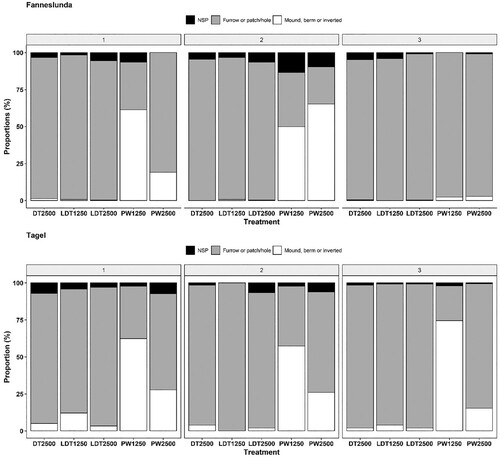
Figure 3. Growth, displayed as the total leading shoot growth, across different planting spot types and study sites split by year. The mortality rates of the seedlings after three growing seasons across the different planting spot types and study sites split by year illustrated below. Letters indicates significant difference between planting spot types. NSP stands for no site preparation.
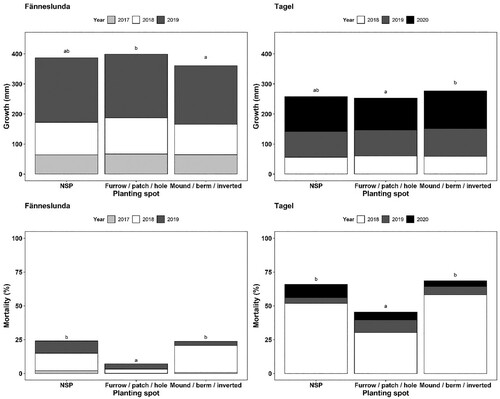
Figure 4. Growth, displayed as the total leading shoot growth, across different soil preparation treatments and study sites split by year. The mortality rates of the seedlings after three growing seasons across the different soil preparation treatments and study sites split by year are illustrated below. Letters indicate significant difference between site preparation treatments. DT2500, Conventional disc trenching; LDT1250, Low-intensity disc trenching with sparse planting; LDT2500, Low-intensity disc trenching with dense planting; PW1250, Low-intensity patch-wise site preparation; PW2500, Patch-wise site preparation.
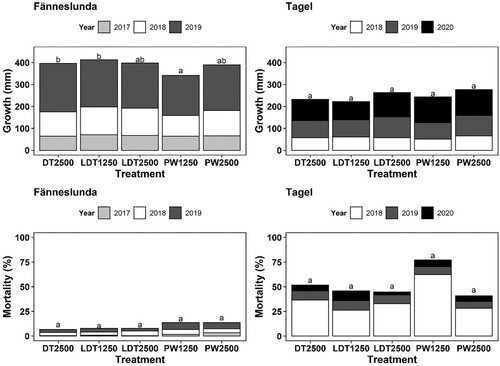
Table 2. The results (p-values) following analysis of variance for the fixed effects on growth and mortality after three growing seasons for Fänneslunda and Tagel.
Figure 5. Effect of slope and eDTW on growth in sites Fänneslunda and Tagel. The graph on the left illustrates the relationship between eDTW and growth after three growing seasons. Hollow dots represent values from Fänneslunda while the filled dots represents values from Tagel. The graph on the right illustrates the relationship between slope and growth after three growing seasons. Hollow dots represent values from Fänneslunda while filled dots represents values from Tagel.
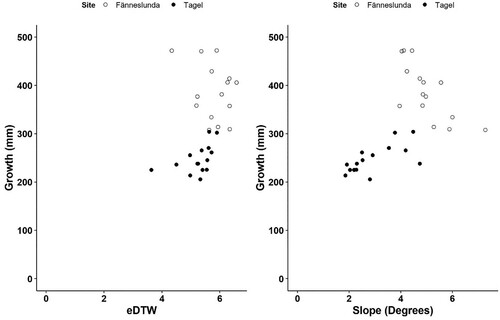
Table 3. The average amount of natural regeneration, along with the proportion of deciduous seedlings as well as field vegetation cover after three growing seasons in Fänneslunda and Tagel for each site preparation treatment on both a circular plot level and planting spot level.
Figure 6. Soil disturbance rate across the different site preparation methods in Fänneslunda and Tagel. Different letters indicate significant differences between site preparation methods. DT2500, Conventional disc trenching; LDT1250, Low-intensity disc trenching with sparse planting; LDT2500, Low-intensity disc trenching with dense planting; PW1250, Low-intensity patch-wise site preparation; PW2500, Patch-wise site preparation. BMS: Bare mineral soil; DH: Disturbed humus; MSH: Mineral soil mixed with humus; MSOH: Mineral soil on top of humus; U: Undisturbed.
